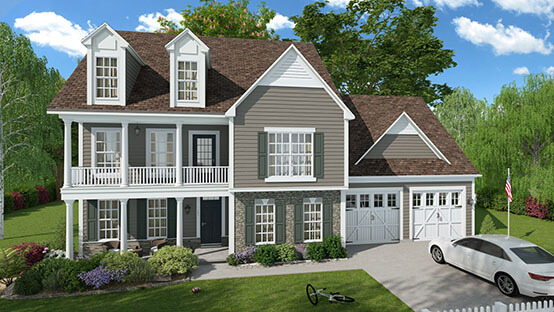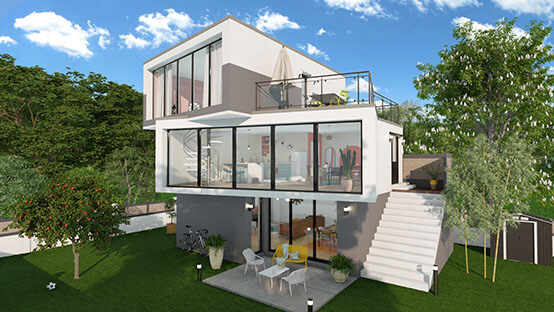Change happens in the construction industry all of the time, but some changes make more of an impact than others. Some changes, in fact, actually change the face of the entire industry. Here’s a great example of one of those changes: virtual design and construction is one of the most.
This is a game-changing development for home builders, remodelers, interior designers and similar professionals that allows them to draft entire projects in detailed 3D before moving even a shovelful of dirt.
If you’re not already doing virtual design and construction (VDC), your business is missing out. Read on to learn everything you need to know about this topic in 2022.
What Is Virtual Design and Construction (VDC)
What is virtual design and construction? It’s right there in the name — it’s the process of designing and “constructing” a building but done virtually rather than in real life. That is the simplest form of the definition, but consider everything that design and construction require when they’re not done virtually: planning, material selection, material sourcing, staffing, scheduling, tool purchase and rental and more. In VDC, all of that is done virtually, requiring a collaborative approach by multiple team members and a healthy helping of long-term planning.
What Is the Difference Between Virtual Design and Construction and Building Information Modeling (BIM)?
The definition of virtual design and construction provided above might have sounded somewhat similar to a concept you’ve heard of before: building information modeling (BIM).
So, what is the difference between VDC and BIM? The answer is a little confusing because the two topics are closely related.
Here’s the breakdown: BIM is one aspect of VDC. It’s the design of a virtual, three-dimensional representation of a planned building. VDC, on the other hand, is about the whole project, including material selection, pricing, scheduling and more, using BIM models to inform the project’s direction.


Virtual Design and Construction Components
Seeing the potential in virtual design and construction is only step one. If you’re interested in using this method to improve your construction business, you need to be able to implement all of the components of VDC correctly.
Here’s what you need to know:
Integrated Concurrent Engineering (ICE) Meetings
Integrated concurrent engineering (ICE) meetings are the cornerstone of a successful VDC project. Why? Because they bring all of the stakeholders on a given construction project together to actually plan out the building process, and that includes designing and making changes based on feedback collaboratively and in real time.
That last part is the “virtual” bit of virtual design and construction. This is usually achieved with a collaborative, cloud-based floor plan and design software that enables changes on the fly and collaboration via remote connections.
It doesn’t take much thinking to see just how much better a few ICE meetings would be than sending hundreds of emails back and forth. These meetings enable the team to communicate better and get more done in less time, with less chance for confusion or misunderstanding.
BIM
After some ICE meetings are on the books, your team will likely have enough information to start the BIM phase. It is here that the finalizing of designs and descriptions happens.
The virtual feedback on the designs happens throughout the entire VDC process, of course, but it is particularly important in the BIM phase. That’s because your team should be putting the finishing touches on particular parts of the home or other building your company has been tasked with constructing.
One of the biggest benefits of the BIM phase is that it pushes your team members forward to making decisions about the final design. Actually putting the flat designs into functional 3D (virtual) form puts potential problems into clear focus, and highly functional teams will take this opportunity to solve the problems that arise here.
Product Production Management (PPM)
The part of your brain that focuses on logistical problems will activate in the product production management (PPM) phase of your virtual design and construction project. That’s because this is the phase in which you start making the plans to make your BIM designs come to real, full, client-thrilling life.
That’s going to require a lot of scheduling of both your staff and subcontractors, as well as sourcing materials and renting or purchasing tools and equipment that the job will require.
9 Benefits of Virtual Design and Construction
We know what virtual design and construction is, but what are its benefits? As it turns out, this innovative method doesn’t have just one benefit, but nine benefits for construction companies. Here are the benefits of VDC you need to know:
1. Win more contracts
As the owner or manager of a construction business, here’s the benefit of VDC that you are likely to care about the most: VDC can help you get more contracts. That means you bring in more revenue and can grow your business.
How, exactly, does virtual design and construction close more deals for you? By giving clients a full picture of what their home or other building would look like if they chose you as their construction company. Seeing a beautiful and detailed 3D image of a future home creates an emotional connection between the client and the proposed project. That emotional connection is worth much more than its weight in gold.
Additionally, your company will look more prepared if you come to a client with a proposal that includes the completed VDC process, scheduling, material selection, staffing, and all.
2. Improve project estimates
If you force yourself to complete virtual design and construction (VDC) before providing an estimate to the client, you will come away with much more accurate estimates. And, as you know, inaccurate estimates upset clients and can lead to negative impacts on your business’ reputation.
Here’s how VDC can improve project estimates: By helping you understand the full scope of the materials involved, as well as the location and any tricky features of the lot, land or jurisdiction. VDC will also provide an idea of the staffing and scheduling you’re going to need to do, meaning you don’t have to guess at this any more. You can include the labor costs in your estimate with confidence if you use VDC.
3. Better communication
Because the ICE meetings involved in virtual design and construction require members of seemingly distant teams within and outside of your company to work together to plan the project at hand, VDC can lead to highly improved communication among your employees when they are speaking or working with each other, vendors, suppliers, subcontractors or the client.
Of course, the benefits of better communication are almost always immediately noticeable. Your team members and clients will be happier because they are understanding each other, and your bank account will smile because you’re not having to constantly undo mistakes caused by poor communication.


4. Keep work on schedule
Doing VDC (virtual design and construction) the right way means you have a rough outline of the project timeline and schedule by the time you make your presentation to the client or customer. So, when the client or customer decides they want to use your business to get their home built, you’re ready to dive right in instead of spending weeks on the phone trying to get in touch with the subcontractors you’re usually able to work with.
Because your VDC work will have set up a collaborative virtual model of the home you intend to build, your team members can update the model when their work is done. That gives each team member a chance to update the virtual model to include the work they have completed.
5. Enhance health and safety
In the age of COVID-19, keeping people out of close quarters as much as reasonably possible is always a good thing. And that’s exactly what VDC promotes — with virtual collaboration in the pre-construction process, team members can be halfway across the world from each other and work on the same project in real time.
But there’s another health and safety bonus of virtual design and construction: It increases planning and the level of detail involved in any project, and planning and detail are how you prevent injuries. Whether it’s by making sure two trades won’t be working in the same area on the same day or ensuring that you’ve ordered enough personal protective equipment for the job, VDC can make your projects safer.
6. Building maintenance simplification
What comes out of the VDC process is a set of detailed virtual plans and processes described in great detail. Preserving these resources can add a lot of value to your services for the future owners of the building you are constructing. One of the key reasons for that is that these visualizations can simplify building maintenance.
A detailed BIM drawing can map out an entire HVAC system, for example, so that the first time the system needs maintenance, the contractor can be absolutely certain of where everything is and how it all fits together. Then, if they make changes, the BIM can be updated to reflect those changes for future contractors to use.
7. Save time and money
Doing things virtually saves time and money. It’s as simple as that. Think about it: You don’t have to break ground before you finalize the design with the client, and you don’t even have to pay a drafter or 3D designer. You simply use software that allows you to quickly create floor plans and make changes in minutes. That’s less spent on not just materials, but on labor, the most expensive part of construction.
The time aspect is reflected in the money-saving aspect. Spending less on labor means you’ve spent less time doing something, in most cases. The best floor plan software will allow you to get done in minutes what used to take weeks.
8. Better collaboration
Almost no industry is as collaborative as construction. Contractors and subcontractors have to work together. Architects have to communicate with clients and builders. Builders have to work with suppliers. Even directly on the job site, dozens of people may be working at once, and they all have to collaborate.
The nice thing about VDC is that it promotes and sharpens the collaborative spirit. It requires collaboration between all of the stakeholders early in the process — before ground is ever broken — so that when it comes time to start the actual, physical work, everyone is already used to working together and shares the same vision for the completed project.
9. Improved quality
Construction companies all over the world wouldn’t be adopting virtual design and construction (VDC) processes if it didn’t help them do their jobs better. This is a process that can take what might have been mediocre or even problematic work and make it truly sparkle. And in a highly competitive business like construction, you need a little sparkle if you aim to get ahead.
Conclusion
Virtual design and construction is an essential part of running any construction business in 2022. There’s no skipping it if you want success, but there are ways to make it much, much easier. Choosing the right software, such as Cedreo, can accelerate the VDC process.
Cedreo is a comprehensive floor planning software that allows you to create stunning photorealistic designs that lead to faster client approvals. That way, you can close more deals in less time and grow your business. Try it today.



